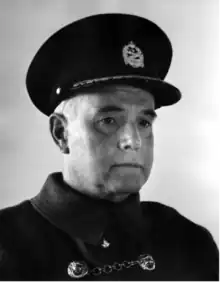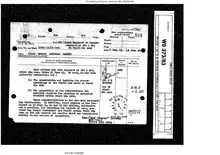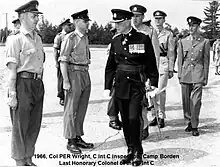Peter Edward Robinson Wright OBE | |
|---|---|
 | |
| Born | July 16, 1910 Toronto, Ontario |
| Died | November 26, 1986 |
| Allegiance | Canada |
| Service/ | Canadian Infantry Corps, Canadian Intelligence Corps |
| Rank | Colonel |
| Battles/wars |
|
| Awards |
|
| Alma mater |
|
| Other work | Ontario High Court of Justice |
Colonel Peter Wright was a Canadian Army Officer who served during the Second World War. He served as the Senior Intelligence Officer with the First Canadian Army in Europe. After the war he returned to work as a lawyer, eventually sitting on the Ontario High Court of Justice.
Early life
Peter Edward Robinson was born July 16, 1910, in Toronto to Edward and Geraldine Wright. His father was a lawyer and Peter went on to train as a lawyer before joining the military at the outbreak of the Second World War. He was educated at St. Andrews University in Scotland and at the Osgoode Hall law school in Toronto.[1]
Early Military Career
September 13, 1939, he entered service in the Royal Regiment of Canada as a Lieutenant and subsequently held various postings with the 4th Canadian Division, the 2nd Canadian Division, 1st Corps and the Canadian Planning Staff.[1]
Raid on Dieppe
Col Wright was involved directly in the Raid on Dieppe. In a post war interview he provided the following comments.
I had the privilege of serving on the HQ ship at Dieppe—the same ship on which were the Force Commander, Hughes Hallett, the Army Commander, MGen J.H. Roberts and the Air Force Commander, Air Commodore Cole. I had the privilege of taking part in all the details of planning for Dieppe. I had also had the privilege of belonging to one of the Regiments that landed 510 men and got ten men back. I had knowledge of the battle and also of the sad results. The 500 who did not come back were among the finest people I have ever known, and the loss of so many of them was something I had more than ordinary cause to be sad about. But I have always felt that Dieppe was a very necessary part of the education of the whole allied effort. I know why in some instances we made the mistakes we did at Dieppe. They were mistakes that were shared at all levels. It was only a lesson such as Dieppe that could teach all the arms that were involved and all the people that were involved that we had to do things somewhat differently. It was an immense sacrifice in Canadian terms. It was made by the Canadians and in my opinion, it was a sacrifice that led directly to our ultimate success in the war.[2]
Intelligence career
In June 1943 Col Wright was posted to 1 Canadian Army HQ as an intelligence officer. All of his previous work had been either as an infantry officer or staff officer and the move came as quite a shock. In a post war interview he provided the following comments on his change.
I was an Infantry Staff Officer. Throughout the war, I did what I was ordered to do. In June 1943, while I was on leave, I received a message that I had been appointed General Staff Officer Grade 1 AIR at 1 Canadian Army HQ. I knew nothing about AIR and so on my way to Edinburgh, I bought a little booklet on “How to Fly” for 9 pence. I read this on my way to Edinburgh and reported in. I was told that I was not G1 AIR, but G1 Intelligence. That is how I started. I succeeded Lord Tweedsmuir who had been G1 Intelligence. He wasn't there when I arrived, but Major George B. MacGillivray was. He was the person who introduced me to Intelligence. It was then that I started working in Intelligence and I did that throughout the rest of the war.[2]
The Ardennes Offensive
When the German Army launched its Ardennes offensive in December 1944, most of the allied forces were caught off-guard by the surprise attack. Lt-Col Peter E.R. Wright as the G2 First Canadian Army, set his staff to work exploiting every possible source of information in order to determine the value of the reports he received. Of the two main sources, nothing was being received from Wireless Intelligence and, the Air Photo Interpretation Section (APIS) was initially prevented by bad flying weather from getting photo coverage.
Information provided by tactical reconnaissance elements in conjunction with air photos that had been rapidly processed in the field as well as Prisoner of War (PW) Interrogation reports, convinced the Canadian Intelligence staffs that the German build-up of offensive forces in the Ardennes was real. The First Canadian Army Intelligence Summary (INTSUM) sent on 26 December 1944 stated, “The enemy appears clearly to have intended to cross the Maas (river) between Geertruidenberg and Heusden. Whether in fact he will do so depends...on the issue of the Ardennes battle [which] must be taken to be pending.”[3] This INTSUM was signed personally by Lt-Col Wright rather than by his duty staff officer. At 1800 hours, he told General Crerar that, in his opinion, the threat was real, not fake. General Crerar replied “I’ve been talking to Monty and he doesn’t think there’s anything in it.” Lt-Col Wright immediately called Brigadier E.T. Williams, BGS (Int), 21 Army Group HQ, and told him of the (evidence in the) pictures and his conclusions. He agreed and said he would speak to General Montgomery. Around 2000 hours, LCol Wright was called to General Crerar’s caravan at Tilburg. He said, “I’ve just been talking to Monty. He thinks there might be something to this threat across the Maas River. We’re deferring the move of Fourth Canadian Armoured Division to XXX Corps and the Guards Armoured Division have been added to our reserve if need be and we’re going to move Army HQ back from Tilburg to Turnhout.” LCol Wright stated “that was the only time I can remember where any appreciation or fact from G (Int) at Army altered the disposition of the Army or its plans.”[4]
OBE Nomination

Col Wright was nominated for the Order of the British Empire by General Crerar shortly after they landed in Europe.[5] The nomination reads as follows:
This officer has been employed as GSO 1 Int, First Cdn Army since 21 June 43. As such, he has been primarily responsible for –
(a) The organization and training for active operations of Int staffs and units of First Cdn Army
(b) The preparation of the comprehensive Int material required for planning of operation OVERLORD within First Cdn Army.
These responsibilities he has met with outstanding distinction. In addition, since landing on the Continent on 16 June 44, he has by his ability, initiative and a devotion, far exceeding the demands of duty, provided for Senior Commanders and Staffs within First Cdn Army an Int and Counter Int service which has contributed notably to the success of operations.
Signed: “HDG Crerar” GOC-in-C First Cdn Army Dated 24 Aug 1944.
Col Wright was awarded the OBE on 1 February 1945 and promoted to Colonel GS (Int.) on May 3, 1945.[1]
Post War Work

At the end of the war, Col Wright is credited with writing First Canadian Army Final Intelligence Report summarizing all Canadian Army intelligence efforts throughout the war. The following quotation is taken from the report.
The primary duty of Intelligence is to give the Commander whatever information he requires about the enemy and to bring any significant changes to his notice immediately.” He further noted that “Intelligence in any formation is based on confidence,” and that there must be “direct access to the Commander and his principal staff officer.” This in turn means “the Intelligence Officer, who is as subject to error as anyone else, must always be prompt and clear in admitting his mistakes.[6]
Col Wright was also involved in the foundation of the Canadian Military Intelligence Association (CMIA), becoming its First President,[7] afterwards he was employed as Barrister and QC by Wright and McTaggert in Toronto. April 3, 1969 he was appointed to the Supreme Court in Toronto and sat on the High Court of Justice until 1977.[1][8]
In February 1964, Col Wright replaced General Harry D.G. Crerar as the Honorary Colonel Commandant (appointed 3 February 1949), of the CMIA. Col Wright contributed much to the development of Army Intelligence in Canada in both peace and war.[9]
Peter Edward Robinson Wright passed away on November 26, 1986.[1]
Honours and awards
- Order of the British Empire (1 February 1945)
- Commander of the Order of Orange-Nassau
References
- 1 2 3 4 5 "Wright, Peter Edward Robinson - TracesOfWar.com". www.tracesofwar.com. Retrieved 2023-08-03.
- 1 2 Skaarup, Harold A. (2005). Out of Darkness - Light. Vol. 1. iUniverse. pp. 363–5. ISBN 978-0-595-34989-0.
- ↑ War Diary 1st Canadian Army. INTSUM 179, 26 December 1944.
- ↑ Elliiot, Stuart Robert (1981). Scarlet to Green (First ed.). Toronto: Canadian Intelligence and Security Association. p. 291. ISBN 9780969054702.
- ↑ Recommendation for Award for Wright, Peter Edward Robinson Rank: Temporary Major... 1944–1945.
- ↑ Col Peter E.R. Wright, First Canadian Army Final Int Report, (Ottawa: King’s Printer, 1946), p. 5.
- ↑ "- Canadian Military Intelligence Association - L'Association Canadienne du Renseignement Militaire". www.cmia-acrm.ca. Retrieved 2023-08-03.
- ↑ "Former Judges". www.ontariocourts.ca. Retrieved 2023-08-03.
- ↑ Skaruup, Harold A. (2005). Out of Darkness - Light. Vol. 1. iUniverse. p. 573. ISBN 978-0-595-34989-0.